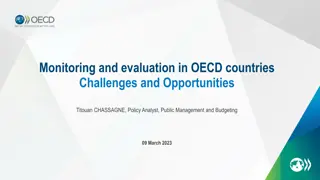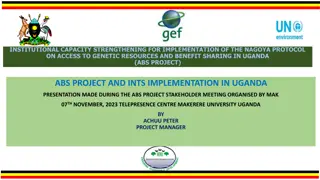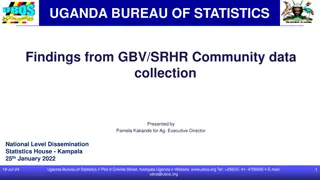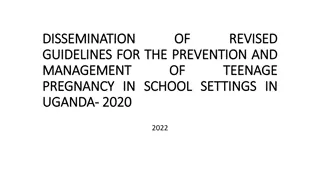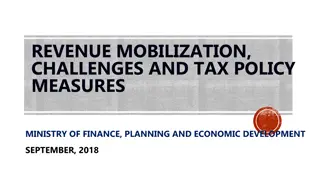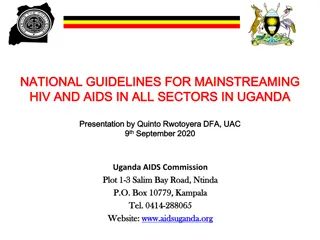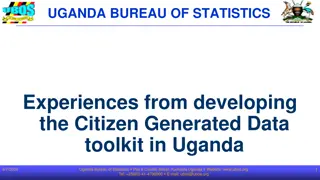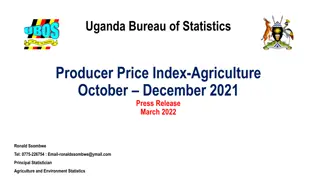
Statistical Development Integration in Uganda: A Comprehensive Overview
Explore Uganda's strategic approach to integrating statistical development into national planning, major statistical data sources, and the institutional framework for statistical funding. Learn about Uganda's vision for economic transformation, key demographic insights, and the importance of statistical insights in driving development outcomes.
Download Presentation

Please find below an Image/Link to download the presentation.
The content on the website is provided AS IS for your information and personal use only. It may not be sold, licensed, or shared on other websites without obtaining consent from the author. If you encounter any issues during the download, it is possible that the publisher has removed the file from their server.
You are allowed to download the files provided on this website for personal or commercial use, subject to the condition that they are used lawfully. All files are the property of their respective owners.
The content on the website is provided AS IS for your information and personal use only. It may not be sold, licensed, or shared on other websites without obtaining consent from the author.
E N D
Presentation Transcript
OUTLINE Introduction Integrating Statistical Development into the National Development Plan process Major Statistical sources in Uganda Institutional environment for statistical funding National Statistical development Securing political commitment for statistical development Conclusion 2
INTRODUCTION Uganda s Vision: A Transformed Ugandan Society from a Peasant to a Modern and Prosperous Country within 30 years Become an upper middle income by 2040,with GDP per Capita of US$9,500, and lower middle income by 2020,with GDP per capita of U$ 1,039 Economy grew at an average of 4.5% over last 5 years, with Per Capita Income currently US$ 737 Population is currently estimated at 37.7 million people & projected at 41.2 million in 2020 Young people constitute the largest share of the population- Aged below 18 years- 57% People living below the poverty line: 19.7% (2012/13) -27% (2016/17) Health outcomes: Infant mortality 43 per 1000 live births; under five 90 per 1000 deaths ; Infant mortality 54 per 1000 live births; Under five 90 per 1000 deaths; Maternal Mortality 336 per 100,000 deaths 3
INTEGRATING STATISTICAL DEVT INTO THE NATIONAL DEVT PLAN PROCESS Statistics is paramount- Short, Medium & Long term Development planning Long Term Census and Survey Programme-enabled the statistical system to generate key statistical information that informs government planning processes Highly informed Uganda s vision 2040 & National Development Planning (NDPI,NDPII) Developed a National Statistical Development System (NSDS)-including all sectors and MDAs involved in generating statistics National Development Plan has an M&E framework-Data on key targets & Indicators Implementing the Programme Based Budgeting (PBB)- focusing on development outcomes-requires statistics 4
MAJOR STATISTICAL SOURCES IN UGANDA National Censuses The National Population & Housing Census Census of Business Establishments Uganda Agricultural Census Key surveys Uganda National Household Survey Uganda National Panel Survey Uganda Demographic Health Survey National Service Delivery Survey Labour Force Surveys Uganda Business Inquiry Private Sector Investment Surveys National Governance Survey Innovation, Research and Development surveys among others 5
INSTITUTIONAL ENVIRONMENT FOR STATISTICAL FUNDING Statistics require modern methods, tools & equipment for data collection Requires substantial resources-Human & Financial Limited domestic revenue mobilisation-Tax/GDP ratio- 13% in Uganda Government funding-major source for funding statistics in Uganda Need for Development Partners to support statistical development in developing countries-Financial &Technical for statistical dev t Using & providing usable quality statistics to inform Dev t Planning-Key for attracting funding both from GoU & DPs Enhancing statistical advocacy to increase demand & attract the requisite funding 6
NATIONAL STATISTICAL DEVELOPMENT Uganda Implementing the Plan for National Statistical Development (PNSD) Phase I & II- funded by DPs (esp. DFID) Enabled the statistical system to strengthen statistical dev t in key MDAs PNSD I led to improvements; Coordination and mgt of statistics production Enhancement of human resource & manpower, dev t of Uganda statistical standards for quality assurance Compilation of key indicators required for the periodic Government Annual Performance Reviews (GAPR); formerly MDG reports; Background to the Budget (BTTB); National Budget Framework Papers; Research; Policy & Management notes among others PNSDII expected to improve data dev t & mgt; Coordination & mgt of the NSS; quality assurance of statistics; dissemination & usability of statistics; Human resource dev t and mgt 7
SECURING POLITICAL COMMITMENT FOR STATISTICAL DEVT Strong political commitment to statistical dev t in Uganda Creation of an independent Bureau of Statistics-Uganda Bureau of Statistics Political will- H.E The President, Cabinet, Parliament among others Awareness creation, esp. political leaders (Cabinet, Parliament, Private sector, CSOs ) Availing timely & quality data/information Supporting regional blocs (EAC,COMESA, AU) Development Partners need to play a critical role in advising Governments on the need for quality statistics 8
CONCLUSION Statistics is critical for development planning & budgeting Should be financed efficiently to promote Sustainable Development Need to produce quality statistics to support evidence based decision making & this will attract funding from both Gov t & Dev t Partners (DPs) Funding should be targeted at areas with No or Scarce data especially Green Economy statistics among others 9




